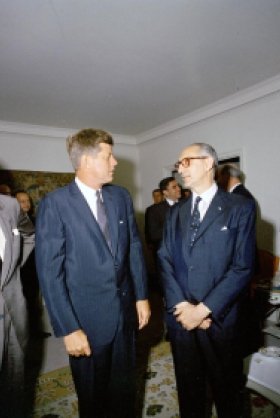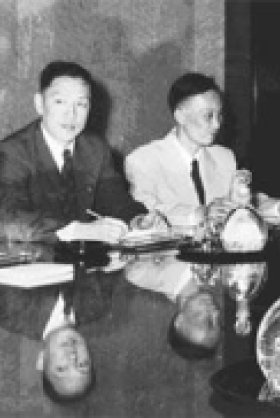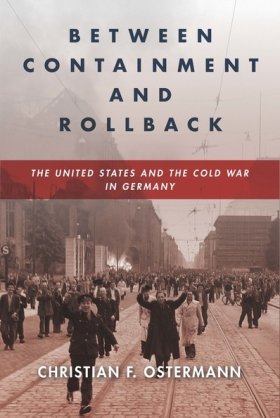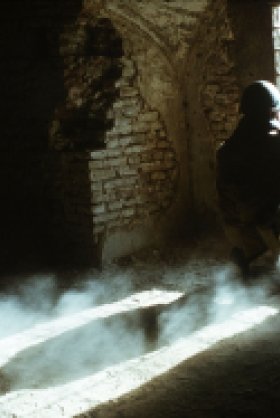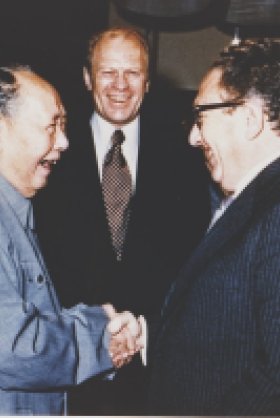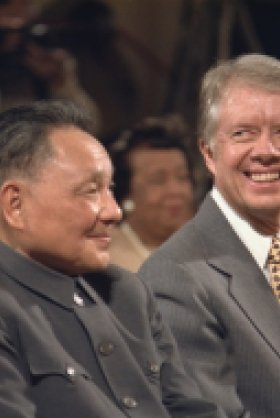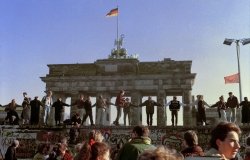William Taubman article in <i>International Herald Tribune</i>
In its 26 July 2003 issue, the International Herald Tribune published an article by William Taubman, author of a new biography of Nikita Khrushchev and CWIHP Advisory Committee chairman, examining the controversy surrounding Nikita Khruschev's famous 1960 "shoe incident" at the United Nations. The article was informed by a heated discussion among several eyewitnesses at a March 2003 CWIHP book launch for Taubman's "Khrushchev." (See the event report on this website.)
Nikita Khrushchev and the Shoe
By William Taubman
The shoe that the world thinks Khrushchev banged at the United Nations is one of history's most iconic symbols. Ask many Westerners, and even quite a few Russians, about the man who succeeded Stalin and then denounced him, who ruled the Soviet Union for a decade and brought to world to the nuclear brink in Cuba, and what they remember most is the shoe. But it may never have happened. The celebrated shoe was allegedly banged on Oct. 13, 1960. A New York Times correspondent, Benjamin Welles, reported that Khrushchev was reacting to a speech by a Philippine delegate who charged that the Soviet Union had ‘‘swallowed up'' Eastern Europe and ‘‘deprived [it] of political and civil rights.'' According to Welles, Khrushchev ‘‘pulled off his right shoe, stood up and brandished the shoe at the Philippine delegate on the other side of the hall. He then banged his shoe on the desk.''
Yet another Times man, James Feron, who was at the United Nations but did not write a story, recalls, ‘‘I actually saw Khrushchev not bang his shoe.'' According to Feron, whom I interviewed in 2002, the Soviet leader ‘‘leaned over, took off a slip-on shoe, waved it pseudomenacingly, and put it on his desk, but he never banged his shoe.''
Did he or didn't he? A KGB general remembered that Khrushchev banged the shoe rhythmically, ‘‘like a metronome.'' A UN staffer claimed Khrushchev didn't remove his shoe (‘‘he couldn't have,'' she recalled, because the size of his stomach prevented him from reaching under the table), but it fell off when a journalist stepped on his heel. The staffer said she passed the shoe wrapped in a napkin to Khrushchev, after which he did indeed bang it. Viktor Sukhodrev, Khrushchev's brilliant interpreter, for Soviet leaders from Khrushchev to Gorbachev remembers that his boss pounded the UN desk so hard with his fists that his watch stopped, at which point, irritated by the fact that some ‘‘capitalist lackey'' had in effect broken a good watch, Khrushchev took off his shoe and began banging.
When I talked about Khrushchev to veterans of his era in Washington, one eyewitness confirmed the banging. But another eyewitness confirmed the nonbanging. A third, who said he'd been standing several feet behind the premier, insisted that the heel of the hand that held the shoe slammed the desk but that shoe never actually touched it.
John Loengard, former picture editor for Life magazine, wrote me that he was in a General Assembly booth, along with 10 or so photographers from New York city dailies and national wire services. Loengard is ‘‘certain'' that Khrushchev ‘‘did not bang his shoe on the desk,'' but that ‘‘he certainly meant to do so.'' According to Loengard, Khrushchev ‘‘reached down and took off a brown loafer from his right foot and put it on the desk. He grinned to delegates from the United Arab Republic who sat across the aisle and mimed (with an empty hand) that the next time he'd use the shoe to bang. I can assure you that every camera in the booth was trained on Khrushchev, waiting for him to use the shoe. He only put it on again and left. None of us missed the picture — which would have been a serious professional error. The event never occurred.'' A woman whose parents emigrated from Ukraine wrote to say that her husband, who was getting ready to go to work, happened to see it as he was walking past the TV. ‘‘He told me to run quickly to watch, and we stood there transfixed,'' she wrote. ‘‘We had a house guest at the time — my cousin Sonia, who was here from the Soviet Union on a visit. When we told her what had happened she didn't believe us. Eventually, other relatives who had also been watching told her they had seen it, too, so she finally conceded he must have done so.''
One might think that the controversy could be resolved by television or photo archives. Several years ago, Khrushchev's son, Sergei, asked NBC and the Canadian Broadcasting Corporation for a tape of the event, but neither could find one. A former CBS Moscow correspondent told me that his search turned up nothing either. My own Internet quest unearthed a photo of the shoe (a light brown sandal, it turns out) on the UN desk, but none of the former colliding with the latter.
Whether Khrushchev banged or merely brandished, the larger question is how to establish truth in history, or whether it can be established at all. A friend in Moscow, a distinguished medieval historian, reacted to the shoe controversy this way, his tongue only partly in cheek: ‘‘If one cannot establish the truth in an event with hundreds of eyewitnesses many of whom are alive and talking, what's the point of reconstructing events centuries old?''
William Taubman is the Bertrand Snell Professor of Political Science at Amherst College. He is the author of Khrushchev: The Man and His Era, published by W. W. Norton in March 2003. His publications include The View from Lenin Hills: Soviet Youth in Ferment (1967), Governing Soviet Cities: Bureaucratic Politics and Urban Development in the USSR (1973), and Stalin's American Policy: From Entente to Detente to Cold War (1982); Moscow Spring (with Jane Taubman, 1989); Khrushchev on Khrushchev by Sergei N. Khrushchev (editor-translator, 1990); and Nikita Khrushchev (co-edited with Sergei Khrushchev and Abbott Gleason, 2000). He has also written op-ed articles and book reviews for The New York Times and other journals.
Taubman currently chairs the Advisory Committee of the Cold War International History Project.
Reproduced with the permission of The International Herald Tribune.
Related Program

Cold War International History Project
The Cold War International History Project supports the full and prompt release of historical materials by governments on all sides of the Cold War. Through an award winning Digital Archive, the Project allows scholars, journalists, students, and the interested public to reassess the Cold War and its many contemporary legacies. It is part of the Wilson Center's History and Public Policy Program. Read more
